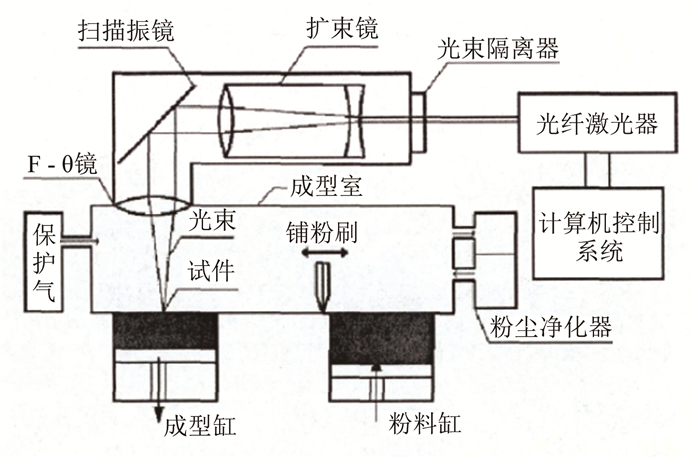Application of additive manufacturing to 30CrMnSiA high speed wind tunnel test model design and fluid-structure interaction analysis
-
摘要: 增材制造技术可针对任意复杂形状的零件进行加工,制造周期和成本较低,具有传统机械切削加工所不具备的独特优势,在风洞试验模型制造中具有广泛的应用前景。针对高速风洞模型加工中常用的30CrMnSiA材料,开展了金属粉末制备、检测及材料试件的制造研究,在此基础上,利用测试件数据作为材料性能输入参数,结合增材制造工艺,设计了机翼为中空结构的AgardB模型,利用Ansys有限元分析软件,进行了该模型流固耦合仿真分析,并开展了优化设计,结果表明,中空机翼的模型结构能够满足高速风洞试验要求。Abstract: Additive manufacturing technology can be processed in any complex shape parts. The short manufacturing cycle and low cost are its unique advantages compared to the traditional machining, and thus it has wide application prospects in the wind tunnel test model manufacture. In view of the material 30CrMnSiA commonly used in the high speed wind tunnel model processing, the metal powder preparation, detection and material specimen manufacture are studied. On this basis, with test piece data as a yardstick for material performance, an AgardB model with hollow airfoil is designed based on the additive manufacturing process. Moreover, fluid-structure interaction analysis is conducted for the model using Ansys and the optimal design is carried out. The results indicate that the model structure can meet the requirement of high-speed wind tunnel testing.
-
Key words:
- additive manufacturing /
- high-speed wind tunnel /
- model /
- fluid-structure interaction /
- Ansys simulation /
- metal powder
-
表 1 常用高能束增材制造技术特点对比
Table 1. Comparison of commonly used high energy beam additive manufacturing technologies
成型技术 适应成型材料 适应成型尺寸 成型精度 应用范围 LENS 金属粉末 大 低,需要3mm左右加工余量 大型难加工金属构件、金属零件修复 EBM 金属粉末 中、小 中 生物医学 SLS 高分子粉末 中、小 高 原型使用 SLM 金属粉末 中、小 高 高精度复杂结构件 表 2 30CrMnSiA球化粉末与锻件材料成分对比
Table 2. Composition comparison of spheroidal 30CrMnSiA powder and forging material
化学组分(wt.pct) C Si Mn Cr Ni Co Mo Cu Fe O/ppm GB 0.28~0.34 0.9~1.2 0.8~1.1 0.2~0.5 Balance 球化30CrMnSiA粉 0.25 1.05 0.9 0.54 1.99 0.058 0.48 0.05 Balance 500 表 3 测试件拉伸性能测试结果
Table 3. Tensile properties results of test specimen
激光功率及试样编号 温度 Rm
/MPaRp0.2
/MPaA
/%E
/GPa180W1# 23 1695 1223 8.1 216 180W2# 23 1486 1170 5.6 204 180W3# 23 1545 1208 6.7 203 180W平均 1575 1200 6.8 207 190W1# 23 1600 1205 5.9 205 190W2# 23 1495 1155 5.8 204 190W3# 23 1527 1190 6.4 199 190W4# 23 1532 1175 6.5 208 190W平均 1539 1181 6.2 204 200W1# 23 1614 1224 8.1 235 200W2# 23 1535 1220 7.1 211 200W3# 23 1510 1167 7.6 202 200W平均 1553 1204 7.6 216 表 4 30CrMnSiA材料属性
Table 4. 30CrMnSiA material performance parameters
材料 Rm
/MPaRp0.2
/MPaE
/GPa密度ρ
/(kg·m-3)30CrMnSiA 1080 835 196 7928.6 增材制造30CrMnSiA 1575 1200 207 7928.6 表 5 流固耦合计算结果
Table 5. The result of fluid-structure interaction
实心翼模型 壁厚1.5mm空心翼模型 壁厚0.8mm空心翼模型 最大允许值 von-Mises应力/MPa 5.515 7.377 7.961 33.33 von-Mises应变 2.558×10-5 3.429×10-5 3.829×10-5 -- 最大变形/mm 0.0752 0.0903 0.0985 0.1361 -
[1] 朱胜, 柳建, 殷凤良, 等.面向装备维修的增材再制造技术[J].装甲兵工程学院学报, 2014, 28(1):81-85. http://d.wanfangdata.com.cn/Periodical/zjbgcxyxb201401017Zhu S, Liu J, Yin F L, et al. Additive remanufacturing technology used in equipment repair[J]. Journal of Academy of Armored Force Engineering, 2014, 28(1):81-85. http://d.wanfangdata.com.cn/Periodical/zjbgcxyxb201401017 [2] Wang L, Liu J. Liquid phase 3D printing for quickly manufacturing conductive metal objects with low melting point alloy ink[J]. Science China Technological Sciences, 2014, 57(9):1721-1728. doi: 10.1007/s11431-014-5583-4 [3] Symes M D, Kitson P J, Yan J, et al. Integrated 3D-printed reaction ware for chemical synthesis and analysis[J]. Nat Chem, 2012, 4:349-354. doi: 10.1038/nchem.1313 [4] 余冬梅, 方奥, 张建斌. 3D打印:技术和应用[J].金属世界, 2013, (6):6-11. http://kns.cnki.net/KCMS/detail/detail.aspx?filename=jssj201306004&dbname=CJFD&dbcode=CJFQYu D M, Fang O, Zhang J B. 3D printing:technology and application[J]. Metal World, 2013, (6):6-11. http://kns.cnki.net/KCMS/detail/detail.aspx?filename=jssj201306004&dbname=CJFD&dbcode=CJFQ [5] 江洪, 康学萍. 3D打印技术的发展分析[J].新材料产业, 2013, (10):30-35. doi: 10.3969/j.issn.1008-892X.2013.10.008 [6] Gu Q, Hao J, Lu Y J, et al. Three-dimensional bio-printing[J]. Science China Life Sciences, 2015, 58(5):411-419. doi: 10.1007/s11427-015-4850-3 [7] 洪兴福. 3D打印技术在高速风洞模型制造中的应用研究方案[R]. 四川绵阳: 中国空气动力研究与发展中心, 2015. [8] 曾光, 韩志宇, 梁书锦, 等.金属零件3D打印技术的应用研究[J].中国材料进展, 2014, 33(6):376-382. https://www.cnki.com.cn/qikan-ZDYY201707012.htmlZeng G, Hang Z Y, Liang S J, et al. The applications and progress of manufacturing of metal parts by 3D printing technology[J]. Materials China, 2014, 33(6):376-382. https://www.cnki.com.cn/qikan-ZDYY201707012.html [9] 蒋小珊, 齐乐华. 3D打印成形微小型金属件的研究现状及其发展[J].中国印刷与包装研究, 2014, 6(5):15-25. http://www.wenkuxiazai.com/doc/44bd64a325c52cc58ad6be8e.htmlJiang X S, Qi L H. Research status and development of 3D printing forming for miniature metal part[J]. China Printing and Packaging Study, 2014, 6(5):15-25. http://www.wenkuxiazai.com/doc/44bd64a325c52cc58ad6be8e.html [10] 朱伟军, 李涤尘, 任科, 等.基于3D打印的舵面可调实用化飞机风洞模型的设计与试验[J].航空学报, 2014, 35(2):400-407. http://d.wanfangdata.com.cn/Periodical/hkxb201402010Zhu W J, Li D C, Ren K, et al. Design and test of a practical aircraft model for wind tunnel testing with adjustable control surfaces based on 3D printing[J]. Acta Aeronautica et Astronautica Sinica, 2014, 35(2):400-407. http://d.wanfangdata.com.cn/Periodical/hkxb201402010 [11] Springer A. Evaluating aerodynamic characteristics of wind tunnel models produced by rapid prototyping methods[J]. Journal of Spacecraft and Rockets, 1998, 35(6):755-759. doi: 10.2514/2.3412 [12] Aghanajafi C, Daneshmand S, Nadooshan A A. Influence of layer thickness on the design of rapid-prototyped models[J]. Journal of Aircraft, 2009, 46(3):981-987. doi: 10.2514/1.39702 [13] Chuk R N, Thomos V J. A comparison of rapid prototyping techniques used for wind tunnel model fabrication[J]. Rapid Prototyping Journal, 1998, 4(4):185-196. doi: 10.1108/13552549810239030 [14] 范立坤.增材制造用金属粉末材料的关键影响因素分析[J].理化检验(物理分册), 2015, 51(7):480-519. http://d.wanfangdata.com.cn/Periodical_lhjy-wl201507008.aspxFan L K. Analysis on key factors of metal powders for additive manufacturing[J]. Physical Testing and Chemical Analysis(Part A:Physical Testing), 2015, 51(7):480-519. http://d.wanfangdata.com.cn/Periodical_lhjy-wl201507008.aspx [15] 姚妮娜, 彭雄厚. 3D打印金属粉末的制备方法[J].四川有色金属, 2013, (4):48-51. http://d.wanfangdata.com.cn/Patent/CN201410028642.2Yao N N, Peng X H. The preparation method of metal powder for 3D printing[J]. Sichuan Nonferrous Metals, 2013, (4):48-51. http://d.wanfangdata.com.cn/Patent/CN201410028642.2 [16] 秦大同, 谢里阳.常用机械工程材料[M].北京:化学工业出版社, 2013. [17] 宋学官, 蔡林, 张华. Ansys流固耦合分析与工程实例[M].北京:中国水利水电出版社, 2012. [18] 陈红. 核阀流体动力学及流固耦合有限元分析[D]. 大连: 大连理工大学, 2013. http://cdmd.cnki.com.cn/Article/CDMD-10141-1013199747.htm [19] GJB569A-2012, 高速风洞模型设计准则[S]. 北京: 总装备部军标出版发行部, 2012. -








 下载:
下载:




































